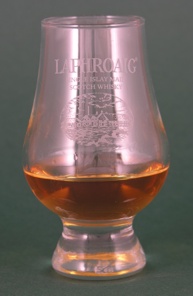|
|
The English translation should be soon online. Click here for the Google automatic translation

The pot stills of Laphroaig
Written by Claudio on 06/10/2009The pot stills of Laphroaig, which is rare in the panorama of whisky’s distilleries, are 7 and don’t work in pair.
Normally, distilleries have two pot stills that work together. To a big wash still correspond a smaller spirit still. All the spirit obtained is flowed into a spirit receiver, a big tub in which the little differences between the distillation couples, when present, will harmonize. Laphroaig is unique under this point of view too. It has 7 pot stills, 3 wash stills (first distillation 12.000 L pot stills) and 4 spirit still (for a second distillation). Among the 4 spirit stills, 3 are smaller (4.700 L) and 1 is two times bigger than the others (9.400 L). This highly complicates the process of distillation.
Laphroaig started to distillate with a couple of pot stills. Thanks to the work of Ian Hunter, around the year 1923, a new couple of pot stills has been added, going from 2 to 4. With the coming of Long John International, in 1967 just one pot still was added – number 5 – a spirit still. Lastly another couple of pot stills has been added in 1072, reaching the 7 pot stills still used today.
The plans to add the eighth pot still (3 wash stills and 5 spirit stills) have never been completed. In fact, at the moment of adding the seventh pot still (spirit still) it has been decided to make it with a double dimension, so to unite the seventh and the eighth in a bigger one. The reasons of this choice are economical, a big pot still costs less then two smaller ones. This way, however, the changings in the organoleptic profile of the new make spirit have been underestimated. Normally, when a new pot still is added in a distillery and an existing one is being repaired, the attention is paid to the maintenance of its form. When you visit the distilleries, it is told that every changing, even the smallest, can be important in the new make spirit. Moreover, when adding new pot stills, if the original ones have irregularities or some treaded parts, those defects are reproduced on the new pot stills. This was probably not a problem for the persons who made this choice in 1972.

|

|
| Still house of Laphroaig. In the picture on the left there is a wash still in the foreground, followed by 3 little spirit stills and the bigger spirit still, the new entry. In the picture on the right, the swan neck of the pot stills is shown together with the spirit safe. | |
Laphroaig’s pot stills are unique for their shapes too. The wash stills have the common shape of an onion. The spirit stills have an unusual shape, with faces and flat bases. They have a strangling to permit steams’ flow, and as a consequence a more significant contact between the spirit and the copper. Moreover, for both the pot stills, steams flow inside the classic gooseneck (ascending) and are brought to the condensers, which are situated inside the still house and not outside in the open air. The stocky shape (and not slim or tall) of the pot stills, especially the spirit stills’ ones, confirms the intention of creating a new make spirit with a strong character, in perfect Laphroaig’s style.
As in most of the distilleries today, all the pot stills are heated up indirectly by the steam with heating coil. Not more with a flame at the base of the pot still, but a big boiler, which produces the steam that flows in a heating coil inside the pot still. This permits firstly, not to have risks of explosion or fire in an alcohol-full place and secondly, to control easier and more precisely the temperature of the ebullient liquid. The first distillation of Laphroaig produces a Low Wine at about 22% ABV. The second distillation heightens to 68% ABV.
 Behind the pot stills there’s the old Spirit Safe in Victorian style.
Manipulating the brass lever it is possible to cut the head, the heart and the tail of the spirit.
The decision of cutting is not computerised but is made personally by the Stillman.
In fact, no computer can be as good as the stillman in making the best cut.
It is here that the simplicity of the distillation merges with the experience of the Stillman to create “the magic”.
Behind the pot stills there’s the old Spirit Safe in Victorian style.
Manipulating the brass lever it is possible to cut the head, the heart and the tail of the spirit.
The decision of cutting is not computerised but is made personally by the Stillman.
In fact, no computer can be as good as the stillman in making the best cut.
It is here that the simplicity of the distillation merges with the experience of the Stillman to create “the magic”.
Ti sfidiamo!
La parola Laphroaig è ripetuta in questo sito per alcune centinaia di volte.
Trova un punto in cui è scritta in modo errato, segnalacelo, e riceverai una mignon di Laphroaig 10yo in omaggio!
EVENTS |
WhiskyClub Italia si PresentaMontorfano Como, 8/11/2014Dopo l’anteprima primaverile allo Spirit of Scotland di Roma, entrano nel vivo le attività di WhiskyClub Italia. Leggi tutto... |
| Gli altri appuntamenti. |
HIGHLIGHTS |
WhiskyClub ItaliaScritto da Claudio Riva il 18/10/2014
Leggi tutto... |
